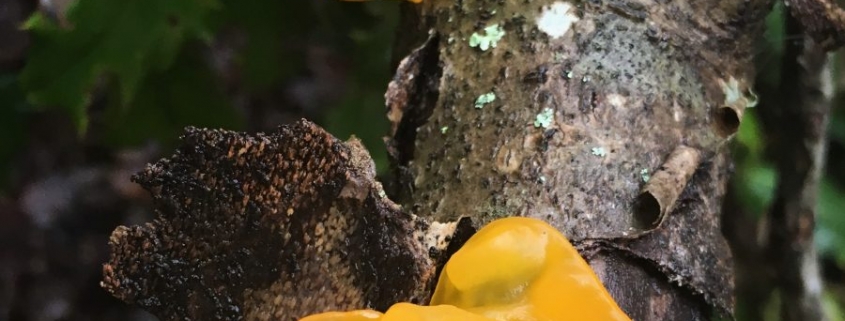Non-Flowering Plants Atop the Mountain at Cheaha: EE AA Annual Conference
This is the third of what will be four posts from my February 28-March 2 visit to Cheaha State Park. I joined some 120 environmental educators attending the annual meeting of the Environmental Educators Association of Alabama (EE AA). The group invited me to present the opening keynote address Thursday evening (2/28). I stayed for the entire conference, enjoying it immensely. This blog post presents the exhilarating diversity of non-flowering plants I encountered during the limited time I ventured outdoors at Cheaha in intermittent rain and nearly continuous fog. In the fourth post I will summarize and highlight my keynote address: Seeing and Translating Nature’s Infinite Storm of Beauty.
My first EE AA meeting post provided a broad conference and Cheaha overview: https://stevejonesgbh.com/2019/03/05/magic-and-wonder-on-the-mountain-an-inspiring-conference-at-cheaha-state-park/ (Magic and Wonder on the Mountain: An Inspiring Conference at Cheaha State Park). Last week’s blog post explored a conflicting set of reactions and reflections to something we observed from the Rock Garden overlook during an interpretive hike: https://stevejonesgbh.com/2019/03/11/scars-upon-the-land-thoughts-stirred-by-a-view-from-cheahas-rock-garden/ .
I begin with a caveat; I am a tree guy. I fully understand the role that non-flowering plants play in our Alabama forests, yet I am convincingly inept at identifying beyond the simple characterization among lichens, mosses, and fungi. I can tell you that I took all of the photos in this post atop Mount Cheaha above 2,000 feet. The two below are views to the WNW (lower left) and N (lower right) from the Rock Garden and Bald Rock, respectively, snapped during one of two times when the views were not cloud- and fog-obscured.
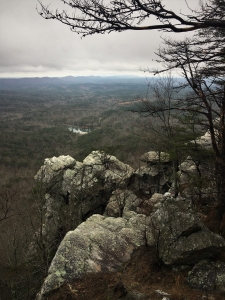
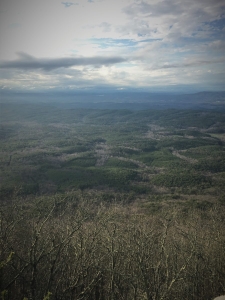
Conditions atop Cheaha are harsh (wind and ice storms). Virginia pine (Pinus virginiana) and chestnut oak (Quercus prinus) dominate the upper elevation forest. Individuals are often battered and broken. Non-flowering plants colonize virtually all bark (dead and living trees) and stone surfaces. Cloudy skies following a rain-soaked morning seemed to intensify the lichen color and contrasts. In fact, the lichens brought vibrancy to the otherwise overwhelmingly drab and dormant scene.
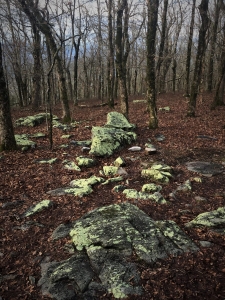
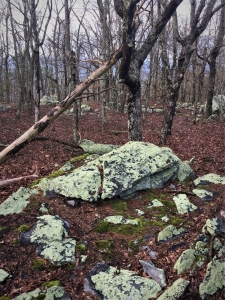
Not just color, but intricate, delicate, and masterpiece-grade patterns, textures, and species admixtures. As I sorted these images I wondered whether anyone has assembled a coffee table quality collection of photographs (taken with a camera several quality steps above my iPhone), complete with detailed identification. I see and appreciate the exquisite beauty, yet that simply reminds me how little I know about these magnificent living organisms. As I enter my second year beyond full-time employment (believe me, university CEO gigs demand 24/7!), I am learning continuously, even as I am constantly learning how little I know about so many things that draw my interest. Non-flowering plants among many such topics. I am not sure, for example, whether the darker green (lower left) is a moss or alga. I believe the rock at lower right supports both crustose and foliose (at top of photo) lichens, with at least two species of the latter. I fear my knowledge is a millimeter deep and kilometers wide.


The foliose lichen below could be a toad skin lichen, one of the rock tripes, yet don’t take that as a firm identification! Or is it possibly a liverwort? Regardless, I find great fascination in examining the non-tree, non-flowering plant life atop Cheaha.
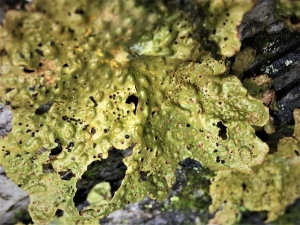
I mentioned the tortured tree forms, savaged by exposure and ice storms. These chestnut oaks epitomize their tough existence. Although one is a ‘V’ and the other a ‘4,’ both play host to lichen cloaks. Again, how drab they would be without their lichen garb.
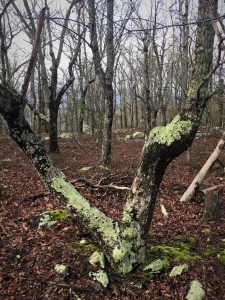
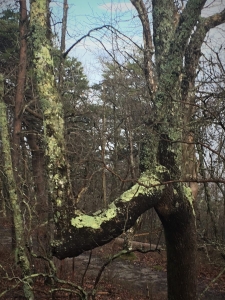
I presume the fructose lichens below represent two species of distinct coloration. I’m also surmising that very slow tree growth and frequent moisturizing fog keep the lichens vibrant. Slow-growing trees severely minimize the rate of bark shedding, allowing lichen colonies to reach greater thickness and extent.
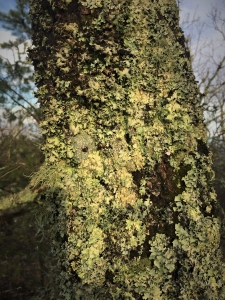
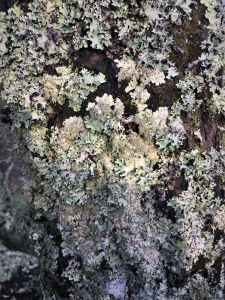
The tapestry of life begs inspection, study, and learning. The stem at lower left presents, again, both crustose and foliose. The old branch stub (lower right) reminds me of a ram’s head adorned in its lichen fur.
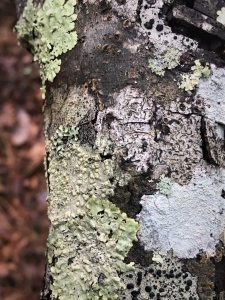
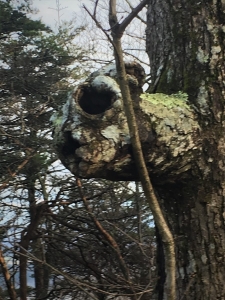
Lichen in combination with moss increments the aesthetic factor, in my view, a minimum of an order of magnitude. The wise person who first observed that nature abhors a vacuum could have been hiking atop Cheaha! Imagine, a bare rock providing such security, anchorage, and nourishment to a living work of art.
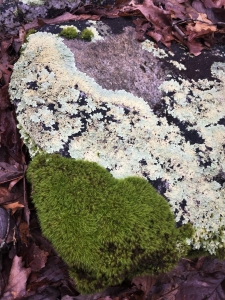
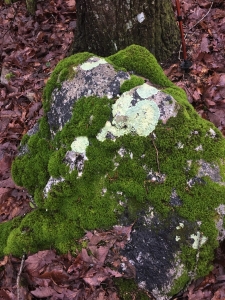
Our 11-year-old Alabama grandson said the lower left image appeared to him as a mountain lake (lichen) surrounded by deep forest (moss) sloping away. I can’t argue with his perspective. A true nature enthusiast must have a vivid imagination and be willing and able to see the beauty, magic, wonder, and awe hidden within. “The power of imagination makes us infinite” (John Muir). Reindeer and crustose lichen and moss populate the rock island (lower right). I considered what adventures (and dangers) I might encounter on the island if reduced to one-inch height.
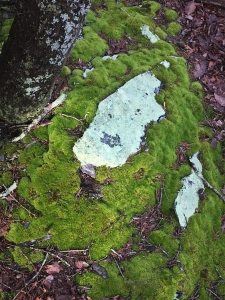
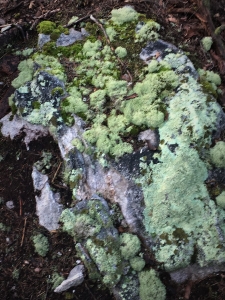
Moss cushions gathered at the base of this chestnut oak (lower left). The fish moss (below right) confirmed for me that we were in the midst (or mists) of an extended period of excessive precipitation! The fish is perched (I couldn’t resist!) on a rock of roughly the same size among the leaf litter. Again, imagination is an essential vehicle for truly enjoying a walk in the woods. Recall Muir’s observation, too, that “In every walk in nature one receives far more than he seeks.”
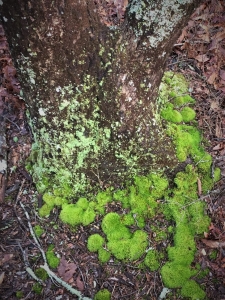
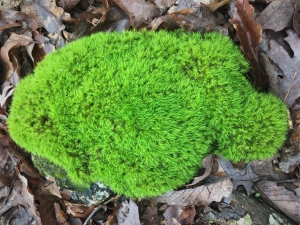
What a treat to find witch’s butter (Tremella mesenterica) on a dead pine branch. This orange jelly fungus, like all the mosses and lichens proliferating atop Cheaha, seemed to relish the wet conditions.
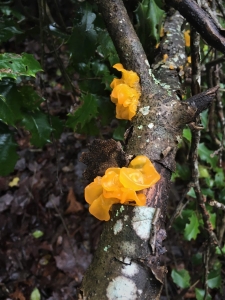
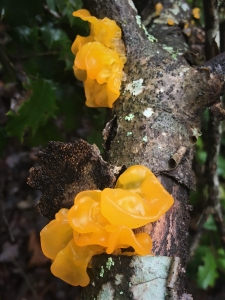
A non-flowering plant specialist could spend hours examining and inventorying the life-richness occupying the standing dead oak sapling and the rock ledge: beard, foliose, and crustose lichens, little tan fungal bodies, and moss. A macro lens in capable hands (with expert knowledge) could reveal mysteries and magic far beyond my simple (and ignorant) aesthetic admiration.
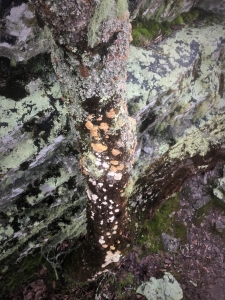
Even we Nature enthusiasts too often focus at landscape scale, seeing only the hills and forests. We sometimes don’t see the trees for the forest, a flip on the old saw about not seeing the forest for the trees. And within the forest we may restrict our sight to the trees, missing the richness, for example, of Cheaha’s incredible palette of non-flowering plants. Imagine the poor soul who stops at the lower elevation scenic overlook (below) and has no hint of the diverse forest life within the forest captured by the few frames within this post. What would I have discovered if I had visited the Park, expecting blue skies and unlimited vistas, and bemoaned the rain and fog. My assumption is that we had few such disappointed visitors among my environmental educator colleagues. They represent the choir of Nature’s sanctuary. Their mission, and mine, is to spread the word and convert more citizens to understand, appreciate, and enjoy Nature… and accept and practice Earth Stewardship.
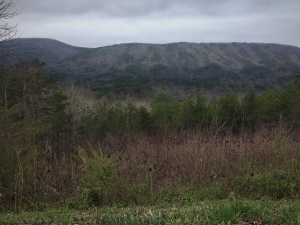
I witnessed and enjoyed spiritual lift from the grand scale (sunset the first evening on Cheaha below) to the witch’s butter on a dead pine branch to the cushion moss fish on the floor of an otherwise drab and colorless, bruised and battered stand of chestnut oak.

I urge all would-be naturalists and Nature enthusiasts to open your eyes and seek the beauty, magic, wonder, and awe that lie hidden within. To those willing to seek, Nature offers unlimited reward. “There’s gold in them thar hills” (Mark Twain), but not of the spending kind. The gold I saw is the inward-investing kind. Gather it through all five portals (body, mind, heart, soul, and spirit), store it internally, and harvest the dividends of enjoyment, satisfaction, and fulfillment!

Thoughts and Reflections
I wrote my books (Nature Based Leadership (2016) and Nature-Inspired Learning and Leading (2017)) and the two scheduled for 2019 (Weaned Seals and Snowy Summits: Stories of Passion for Place and Everyday Nature and Natural Elixir: Lifting Your Life through Nature’s Inspiration) to encourage all citizens to recognize and appreciate that every lesson for living, learning, serving, and leading is either written indelibly in or is powerfully inspired by Nature. Both published books are available on Amazon and other online sources.
Here are three succinct lessons I draw from this Blog Post:
- In every walk with nature one receives far more than he seeks (John Muir).
- So much of Nature’s beauty, magic, wonder, and awe lie hidden in plain sight.
- There’s gold in them thar hills (Mark Twain) — gold of the inward-investment kind!
Inhale and absorb Nature’s elixir. May Nature Inspire and Reward you!
Note: All blog post images created & photographed by Stephen B. Jones unless otherwise noted. Please circulate images with photo credit: “©2019 Steve Jones, Great Blue Heron LLC. All Rights Reserved.”
Another Note: If you came to this post via a Facebook posting or by an another route, please sign up now (no cost… no obligation) to receive my Blog Post email alerts: https://stevejonesgbh.com/contact/
And a Third: I am available for Nature-Inspired Speaking, Writing, and boutique Consulting — contact me at steve.jones.0524@gmail.com
Reminder of my Personal and Professional Purpose, Passion, and Cause
If only more of us viewed our precious environment through my own filters. If only my mission and vision could be multiplied untold orders of magnitude:
Mission: Employ writing and speaking to educate, inspire, and enable readers and listeners to understand, appreciate, and enjoy Nature… and accept and practice Earth Stewardship.
Vision:
- People of all ages will pay greater attention to and engage more regularly with Nature… and will accept and practice informed and responsible Earth Stewardship.
- Great Blue Heron clients will see their relationship to our natural world with new eyes… and will understand more clearly their Earth home.
Tagline: Steve (Great Blue Heron) encourages and seeks a better tomorrow through Nature-Inspired Living!


